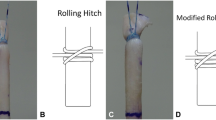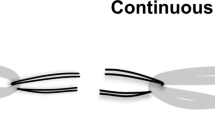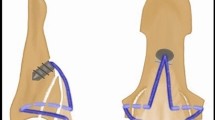Abstract
Purpose
Most biomechanical investigations of tendon repairs were based on output measures from hydraulic loading machines, therefore, accounting for construct failure rather than true gapping within the rupture zone. It was hypothesized that the elastic capacity of a tendon-repair construct influences the force necessary to induce gapping.
Methods
A tendon-repair model was created in 48 porcine lower hind limbs, which were allocated to three fixation techniques: (1) Krackow, (2) transosseous and (3) anchor fixation. Loading was performed based on a standardized phased load-to-failure protocol using a servohydraulic mechanical testing system MTS (Zwick Roell, Ulm, Germany). Rupture-zone dehiscence was measured with an external motion capture device. Factors influencing dehiscence formation was determined using a linear regression model and adjustment performed as necessary. A 3-mm gap was considered clinically relevant. Analysis of variance (ANOVA) was used for comparison between groups.
Results
The elastic capacity of a tendon-repair construct influences the force necessary to induce gapping of 3 mm (F3mm) [β = 0.6, confidence interval (CI) 0.4–1.0, p < 0.001]. Furthermore, the three methods of fixation did not differ significantly in terms of maximum force to failure (n.s) or F3mm (n.s).
Conclusion
The main finding of this study demonstrated that the higher the elastic capacity of a tendon-repair construct, the higher the force necessary to induce clinically relevant gapping.
Level of evidence
Controlled biomechanical study.





Similar content being viewed by others
References
Boin MA, Dorweiler MA, McMellen CJ, Gould GC, Laughlin RT (2017) Suture-only repair versus suture anchor-augmented repair for achilles tendon ruptures with a short distal stump: a biomechanical comparison. Orthop J Sports Med 5:2325967116678722
Ciriello V, Gudipati S, Tosounidis T, Soucacos PN, Giannoudis PV (2012) Clinical outcomes after repair of quadriceps tendon rupture: a systematic review. Injury 43:1931–1938
Clanton TO, Haytmanek CT, Williams BT, Civitarese DM, Turnbull TL, Massey MB et al (2015) A biomechanical comparison of an open repair and 3 minimally invasive percutaneous achilles tendon repair techniques during a simulated, progressive rehabilitation protocol. Am J Sports Med 43:1957–1964
Cox JT, Shorten PL, Gould GC, Markert RJ, Barnett MD Jr, Laughlin RT (2014) Knotted versus knotless suture bridge repair of the achilles tendon insertion: a biomechanical study. Am J Sports Med 42:2727–2733
Dwyer CL, Dominy DD, Cooney TE, Englund R, Gordon L, Lubahn JD (2015) Biomechanical comparison of double grasping repair versus cross-locked cruciate flexor tendon repair. Hand (N Y) 10:16–22
Gelberman RH, Boyer MI, Brodt MD, Winters SC, Silva MJ (1999) The effect of gap formation at the repair site on the strength and excursion of intrasynovial flexor tendons. An experimental study on the early stages of tendon-healing in dogs. J Bone Jt Surg Am 81:975–982
Gilmore JH, Clayton-Smith ZJ, Aguilar M, Pneumaticos SG, Giannoudis PV (2015) Reconstruction techniques and clinical results of patellar tendon ruptures: evidence today. Knee 22:148–155
Grieco PW, Frumberg DB, Weinberg M, Pivec R, Naziri Q, Uribe JA (2015) Biomechanical evaluation of varying the number of loops in a repair of a physiological model of Achilles tendon rupture. Foot Ankle Int 36:444–449
Hart ND, Wallace MK, Scovell JF, Krupp RJ, Cook C, Wyland DJ (2012) Quadriceps tendon rupture: a biomechanical comparison of transosseous equivalent double-row suture anchor versus transosseous tunnel repair. J Knee Surg 25:335–339
Havulinna J, Leppanen OV, Jarvinen TL, Goransson H (2011) Comparison of modified Kessler tendon suture at different levels in the human flexor digitorum profundus tendon and porcine flexors and porcine extensors: an experimental biomechanical study. J Hand Surg Eur Vol 36:670–676
Huri G, Bicer OS, Ozgozen L, Ucar Y, Garbis NG, Hyun YS (2013) A novel repair method for the treatment of acute Achilles tendon rupture with minimally invasive approach using button implant: a biomechanical study. Foot Ankle Surg 19:261–266
Jordan MC, Boelch S, Jansen H, Meffert RH, Hoelscher-Doht S (2016) Does plastic suture deformation induce gapping after tendon repair? A biomechanical comparison of different suture materials. J Biomech 49:2607–2612
Jordan MC, Hoelscher-Doht S, Fehske K, Gilbert F, Jansen H, Meffert RH (2015) Bunnell or cross-lock Bunnell suture for tendon repair? Defining the biomechanical role of suture pretension. J Orthop Surg Res 10:192
Kanz BN, Morris RP, Lewis T, Panchbhavi VK (2014) Biomechanical evaluation of a knotless barbed suture repair in a human Achilles tendon rupture model. Foot Ankle Spec 7:176–181
la Fuente C, Cruz-Montecinos C, Schimidt HL, Henriquez H, Ruidiaz S, Carpes FP (2017) Biomechanical properties of different techniques used in vitro for suturing mid-substance Achilles tendon ruptures. Clin Biomech (Bristol Avon) 50:78–83
Lantto I, Heikkinen J, Flinkkila T, Ohtonen P, Leppilahti J (2015) Epidemiology of Achilles tendon ruptures: increasing incidence over a 33-year period. Scand J Med Sci Sports 25:e133–e138
Rawson S, Cartmell S, Wong J (2013) Suture techniques for tendon repair; a comparative review. Muscles Ligaments Tendons J 3:220–228
Sadoghi P, Rosso C, Valderrabano V, Leithner A, Vavken P (2012) Initial Achilles tendon repair strength—synthesized biomechanical data from 196 cadaver repairs. Int Orthop 36:1947–1951
Saragaglia D, Pison A, Rubens-Duval B (2013) Acute and old ruptures of the extensor apparatus of the knee in adults (excluding knee replacement). Orthop Traumatol Surg Res 99:S67–S76
Smith AM, Forder JA, Annapureddy SR, Reddy KS, Amis AA (2005) The porcine forelimb as a model for human flexor tendon surgery. J Hand Surg Br 30:307–309
Van Dyke RO, Chaudhary SA, Gould G, Trimba R, Laughlin RT (2017) Biomechanical head-to-head comparison of 2 sutures and the giftbox versus Bunnell techniques for midsubstance Achilles tendon ruptures. Orthop J Sports Med 5:2325967117707477
Yammine K, Assi C (2017) Efficacy of repair techniques of the Achilles tendon: a meta-analysis of human cadaveric biomechanical studies. Foot (Edinb) 30:13–20
Funding
The study was financed by institutional research funds.
Author information
Authors and Affiliations
Corresponding author
Ethics declarations
Conflict of interest
The authors declare that they have no conflict of interest.
Ethical approval
The controlled biomechanical study did not require an ethical approval.
Informed consent
For this type of study formal consent is not required.
Rights and permissions
About this article
Cite this article
Ateschrang, A., Salewski, C., Ahrend, MD. et al. The elastic capacity of a tendon-repair construct influences the force necessary to induce gapping. Knee Surg Sports Traumatol Arthrosc 27, 971–977 (2019). https://doi.org/10.1007/s00167-018-4972-9
Received:
Accepted:
Published:
Issue Date:
DOI: https://doi.org/10.1007/s00167-018-4972-9




